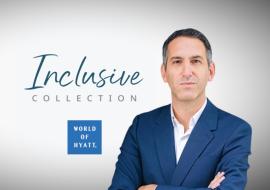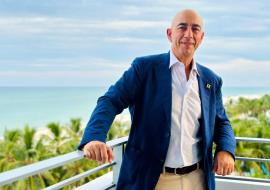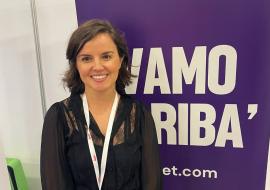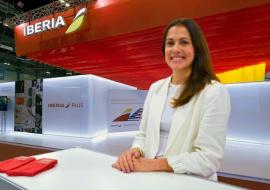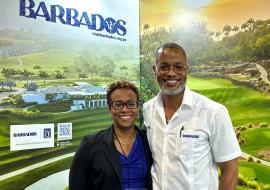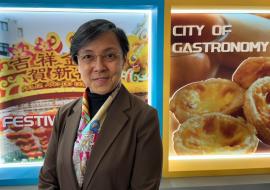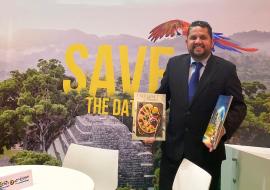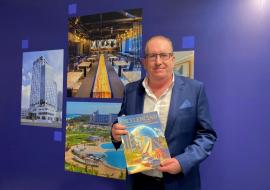Jennifer Champsaur, Panama’s Tourism Deputy Minister
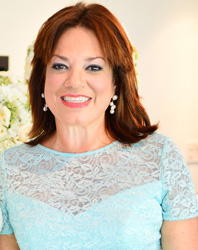
We sat down with Jennifer Champsaur, Panama’s Tourism Deputy Minister, who shared with Caribbean News Digital her opinion on the travel industry’s development in her country, the destinations they are targeting and new opportunities for the isthmus within the framework of the shifting relations between Cuba and the United States.
When did you join the travel industry?
Since I was just a little girl. The question should be if I was being paid or not. My family has always been linked to the worlds of hotels and airlines. In fact, in the very beginning my mother worked for Braniff and she entered the hotel sector some years later. For as long as I can remember, I’ve been running between airports and hotels. Tourism is something to be lived with passion, so I studied Marketing with special emphasis on Hotel Management.
I was a member of the team that opened Marriott Panama and, two years later, I moved to Miami, where also played a role in the inauguration of JW Marriott Miami. Two years after that the love for Panama made me come back.
I worked for Caesar Park Hotel. Afterwards, I joined a representation office as general agent of Marriott Hotels abroad and, at the same time, I represented Marriott Vacation Club.
What does Panama need right now from your administration?
Exploiting the diversity of products we have in the country. We’ve preserved our native cultures, we have exotic wildlife. It’s great to think that one day you can be in the Caribbean Sea and you can cross to the Pacific. Panama is far more than just a canal: we have impressive nature, a lot of ecotourism, adventure, shopping. I strongly believe that Panama has everything.
The Museum of Biodiversity, designed by architect Frank Gehry, was recently inaugurated. I think it’s an interesting attraction with a lot of history, the opportunity to learn how Panama linked both North America and South America when it surfaced, the development of that platform, the way Panama is presently protected from natural disasters, hurricanes, earthquakes.
I believe that it’s a privileged land and I always say that Panama has been blessed by God. We don’t face natural disasters and we have a Canal that stands as one of the wonders of the world. Its expansion should be done by late 2016. We have San Blas Archipelago with over 365 islands to be visited, they are all virgin islands.
It’s a very interesting product, especially for the European market when it comes to planning vacations. They have to know there is a different choice. A lot of people see Panama as a cosmopolitan destination, with huge buildings, a city that could compete with large cities in the United States. I believe that the Latin taste, that Latin culture, is behind all that. The combination of both elements leaves no room for doubts, because a traveler that goes from Europe to Latin America wants to have at least a 7-day vacation, while they adapt to time difference and everything else. They can spend up to 14 days without staying in the same place, and they can enjoy many activities. It’s a small destination, but it features a tremendous diversity of products.
What is Panama’s policy to attract MICE groups?
There are two important aspects. When you are working in the MICE business and you’re going to choose a destination for meetings, incentives, the first element to be taken into account is airlift, followed by hotel infrastructure. I believe that we master both factors. Our airlift is impressive: we have nearly 1,500 weekly frequencies, which facilitates the coordination of MICE groups. Our hotel infrastructure is made up of over 300 hotels. Most of the main hotel companies are present in Panama.
Between 2009 and 2014 we grew up with nearly 10 thousand rooms available, which is not much for big countries, but it’s an interesting figure for a nation like Panama, even more if it’s compared to the rest of the region.
If you add to the list the construction of the brand-new convention center in Amador, I believe that you get a pretty interesting destination for the MICE segment, the one that actually motivates me.
Do you think that you could make the arrangements to have scholarships abroad in order to train travel industry professionals?
Definitively, if we look back to every interview or statement, the training matter always comes up. The growing number of hotels and airlift entails hiring more people to cover all those positions and there was a time when this accelerated growth wasn’t backed up by the number of professionals.
We have to go to schools, universities to promote these things. Sometimes you find young people studying at schools, but they don’t actually know what to study. The idea of being a doctor or a lawyer has prevailed for a long time and they don’t realize that the market needs have evolved.
This administration has placed emphasis on the education and training matters. We have the National Institute to Develop Human Resources. We’re working to have the students prepared and trained to meet the requirements of 5-star hotels. There was a gap between those two aspects, so when they graduated they were educated but not ready to face the market.
We are working on the scholarship matter and, in fact, we’re looking for options with foreign universities to educate our students in terms of the travel industry.
What are your target markets in Latin America?
Colombia has always been a very important market to Panama. I would say that, right after the United States, Colombia is Panama’s second tourism outbound market.
We see potential in Brazil for this year or the near future. The Brazilian market loves shopping destinations and Panama is positioned as a shopping destination in the region. We’re putting our bet on Brazil. Copa has opened new flight frequencies to Brazil, not only from Sao Paulo or Rio de Janeiro. We’re looking forward to having a significant Brazilian market.
As for cruises, we have a home port with Pullmantur in Panama, which will be bringing a second vessel by late 2015. I know that this choice is also going to be acclaimed in Brazil. We have already been visited by important Brazilian tour operators, who are interested in working together to move as many tourists as possible.
What are the main tourism outbound Mexican states?
Mexico is very big and they sometimes sell their own products. The people that live in the DF would rather go to Cancun for vacation or Monterrey for business; they move within their own country. It’s also complicated for the MICE market because they try to stay in the country and move their internal tourism.
However, I think it’s a destination with great potential. AeroMexico will start flying to Panama this year and I’m sure that’s going to be very helpful. We’re also going to have Mexico as a connection bridge with Europe.
I think that we need to intensify our work with Brazil and Mexico. It doesn’t mean that we’re not interested in the European market. I believe that when the Latin American market is compared, you can take three or four days of vacation, just like you’d do in Europe. When you travel from Latin America to Europe you want to spend at least one or two weeks. The same happens when European tourists go there: they always go for two weeks. The efforts to bring tourists represent longer stay, so three nights can become seven or ten at the destination.
The combination must be very strategic in order to attract tourists from those important Latin American markets and Europe. We cannot forget about Europe.
Do you think that Mexico can also see Panama as an outbound market?
Of course, I do. I think that it’s even complicated for Mexicans to go to the DF because of the congestion. Right the people don’t even want to drive because it takes nearly two hours to go from Puebla to Mexico.
What cruise companies are going to visit Panama?
As partial traffic they sail up to Gatun Lake, disembark and take passengers in Colon. We’re receiving Celebrity, Princess, most of the cruise lines. Everybody thought that cruises had abandoned us. They go up the Canal. The point is that the traffic is partial. All cruise lines sail across the Canal. If you open the itineraries of Carnival, Royal, Celebrity, we have them all.
We actually need more home ports. When you have a home port the visitors arrive in the destination two or three days in advance and they later board the cruise. This element contributes to the development of the economy and travel industry.
What tourists spend more money in Panama? What are the nationalities?
That’s very relative. There is no exact number. There are figures in percentage terms related to the average spending of a tourist in the destination, according to the cost of the three meals plus shopping. Nonetheless, the number is not accurate.
I can actually tell you that there are behavior patterns. For instance, we have the Dominican trend. Dominican visitors arrive in Panama, get off the plane, go to the duty free zone, spend some thousands, over 8 or 9 with their credit card, and leave. Many of them come through the border, go to the gas station, do their shopping and go to the restaurant.
There are different behaviors and we have to analyze how to make the people know the great diversity of products we have in our destination, it’s not only about shopping.
The new context of Cuba-US relations could benefit Panama. If Copa flies to Cuba and the right advertising campaign is developed, many of those people could spend at least one day in Panama.
Copa’s stopover is a subject to be mastered by travel agents, because Copa’s only restriction was related to the fact of requesting it when issuing the plane ticket, they can’t change it after that. If travel agents are not aware of it, for example the flight goes Miami - Havana via Panama without stop over.
We’re working with Copa. The work will include marketing teams related to Copa, private companies and ourselves as governmental institution, so we can launch the proper promotion for these destinations.
With the Cuba issue, United States is definitively going to increase the number of visitors and Panama will be the route, by means of Copa. We have to work hard to make Panama be attractive for those who want to visit Cuba.
Fourteen daily frequencies are scheduled. That represents nearly 3 thousand passengers on a daily basis.
When you multiply by the number of available plane seats, you get the statistics. How many passengers do you think go through Panama’s Tocumen airport? Some 7 million passengers and the annual number of visitors is 2.3 million. If we could just turn Tocumen airport into a destination, I think that we would do great.







